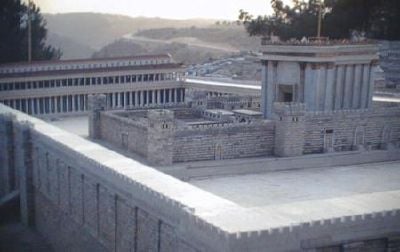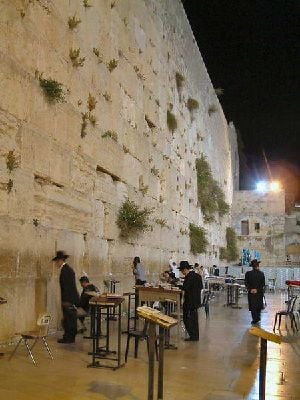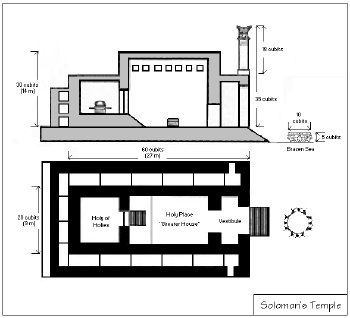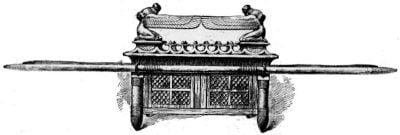Temple of Jerusalem
The Temple in Jerusalem was originally built in ancient Jerusalem in c. tenth century B.C.E. Also known as Solomon's Temple, it was the national center of Israelite religious life, especially for the offering of sacrifices, but also as a cultural and intellectual center. It was located on Jerusalem's Temple Mount. Its architecture and rich furnishings are described in considerable detail in the Hebrew Bible. The most famous artifact in Solomon's Temple was the legendary Ark of the Covenant. According to the Bible, Solomon's Temple replaced the Tabernacle of Moses and was to be the sole place of legitimate sacrificial offering to God in both Judah and Israel.
The original Temple was destroyed in 586 B.C.E. by the Babylonians and was rebuilt in stages after the Jews returned from exile. This, the Second Temple, served as the religious center of Jewish life in the post-exilic period. Herod the Great greatly expanded the Temple in the late first century B.C.E. The Second Temple was destroyed in 70 C.E. by the Romans. The site of the Temple is now believed to be occupied by the Al Aqsa Mosque, one of the holiest shrines for the Muslim faith. The Temple remains an important focus of Jewish prayers, and the Western Wall, the remnant of a retaining wall surrounding the temple, is a sacred place of pilgrimage to this day.
First and Second Temples, and Other Temples
Several distinct sacrificial sanctuaries stood in succession on the Temple Mount in Jerusalem:
- King David's Altar was the first construction on the site of the temple mount. Second Samuel 24:18-24 describes a sacrificial altar on the future temple site, built on a former threshing floor,
- Solomon's Temple was built in approximately the tenth century B.C.E. It was destroyed by the Babylonians under Nebuchadnezzar II of Babylon in 586 B.C.E.
- The Second Temple was built after the return from the Babylonian Captivity, around 536 B.C.E. The temple narrowly avoided being destroyed in 332 B.C.E. when the Jews refused to acknowledge the deification of Alexander the Great of Macedonia. In 175 B.C.E. Antiochus IV Epiphanes ascended to the throne and pursued a policy of Hellenization. Religious observances of Sabbath and circumcision were outlawed, and a statue of Zeus was erected in the temple and Jews were commanded to offer sacrifices to it. In 167 B.C.E. the Jews rose up against Seleucid authority, and in 165 B.C.E. Judah Maccabee re-dedicated the temple. The Jews celebrate this event to this day as the central theme of the festival of Hannukah.
- Herod's Temple was a massive renovation of the original Second Temple which took place around 20 C.E.; it included turning the entire Temple Mount into a giant square platform. Herod's Temple was destroyed by Roman troops under general Titus in 70 C.E.
- During the Bar Kochba revolt against the Romans in 132–135 C.E., Simon bar Kokhba and Rabbi Akiva wanted to rebuild the Temple. However, the revolt failed and the Jews were banned from Jerusalem by the Roman Empire. There was also an aborted project by the Roman emperor Julian the Apostate (361-363 C.E.) to allow the Jews to build a "Third Temple" as part of Julian's program of restoring local religious cults.
By custom, Herod's Temple is not called the "Third Temple" because the priesthood kept the animal sacrifices and other ceremonials going without interruption during the entire reconstruction project. While Herod's Temple itself was subsequently destroyed, the mammoth Temple Mount platform complex still exists and currently supports the Dome of the Rock and Al-Aqsa mosques. It is the remnant of the Western Wall of this complex, formerly called the "Wailing Wall," that is one of Judaism's most holy sites.
Construction and Description
While contemporary scholarship challenges the Bible's story of Solomon's Temple's construction as either anachronistic or exaggerated, the account is worth considering in some detail.
Before his death, King David reportedly provided materials in great abundance for the building of the Temple on the summit of Mount Moriah (1 Chron. 22:14; 29:4; 2 Chron. 3:1), where he had established a sacrificial altar after purchasing a former threshing floor from Araunah the Jebusite (2 Sam. 24). Mount Moriah was the traditional location of Abraham's preparation to sacrifice his son Isaac as a burnt offering to God (Gen. 2:22).
King Solomon prepared additional materials for the building. From subterranean quarries at Jerusalem he obtained huge blocks of stone for the foundations and walls of the structure. He entered into a pact with Hiram I, king of Tyre, for additional materials for the work, particularly timber from the forests of Lebanon (1 Kings 5).
Solomon also provided for a sufficient water supply for the Temple by creating vast cisterns, into which water was conveyed by channels from the "pools" near Bethlehem. One of these cisterns was the "great sea," a massive cast bronze pool that stood impressively at the Temple's entrance.
The huge building project began, under the direction of skilled Phoenician workmen, in the fourth year of Solomon's reign. The Biblical account reports that this involved 100,000 talents (3000 tons) of gold and one million talents (30,000 tons) of silver. (Modern scholars suspect that these figures were exaggerated.)[1] Thousands of laborers and skilled artisans were reportedly employed in the work, many of them non-Israelite slaves who the Bible identifies as survivors of the wars of conquest in Canaan. The building is described as 60 cubits (27 meters) long, 20 cubits (9 meters) wide, and 25 or 30 cubits high (ancient manuscripts differ on this detail).
In the eleventh year of his reign, seven and a half years after it had been begun, Solomon's Temple was completed. The dedication of the Temple did not take place for several additional years, however. Then, the Ark of the Covenant was solemnly brought from the tent in which David had deposited it to the place prepared in the Holy of Holies (see below). It is said that Solomon ascended a platform and, lifting up his hands to heaven, poured out his heart to God in one of the Bible's most memorable prayers (1 Kings 8; 2 Chron. 6-7). The huge feast of dedication, which lasted seven days, marked a new era in the history of Israel.
- Note: Archaeologists have called into question existence of so grand a building project in tenth-century Jerusalem. Evidence suggests that Judah was too sparsely populated, and Jerusalem far too small a village in David and Solomon's day to have supported construction, wealth, and a labor pool on the scale described. A possible alternative explanation is that that the Temple was built or expanded later in Judah's history and then ascribed to Solomon's era, which was seen by the Biblical authors as a Golden Age of unrivaled wealth, power, and (initially at least) religious piety.
Description
Descriptions of Solomon's Temple vary according both to interpretation and the differing accounts of the Temple in several Biblical books. The following enumeration is largely based on Easton's Bible Dictionary[2] and the Jewish Encyclopedia [3]
- The Debir: the Most Holy Place (1 Kings 6:19; 8:6), called also the "inner house" (6:27), and the "Holy of Holies" (Heb. 9:3). In it was housed the sacred Ark of the Covenant. It was windowless and cubicle in shape: 20 cubits in length, breadth, and height. (A cubit was the measure of length from a man's wrist to his elbow.) It was floored and wainscotted with cedar (1 Kings 6:16), and its walls and floor were overlaid with gold (6:20, 21, 30). It contained two large gold-plated statues of cherubim carved from olivewood, each 10 cubits high (1 Kings 6:16, 20-21, 23-28) and each having outspread wings 10 cubits from tip to tip. Standing side by side, the wings of these impressive statues touched the wall on either side and met in the center of the room. The room was adorned with an ornate embroidered linen veil of blue, purple and crimson (2 Chron. 3:14; compare Exodus 26:33). It was considered the dwelling-place of God, in which his holy presence was enthroned above the cherubim on the Ark of the Covenant. In some accounts, only the High Priest was allowed to enter the Holy of Holies. According to 1 Kings 7:48, there stood before the Holy of Holies a golden altar used for incense offerings and a table for showbread. This table too was made of gold, as were the five candlesticks on each side of it. The implements for the care of the candles—tongs, basins, snuffers, and fire-pans—were also made of gold as so were the hinges of the doors.
- The Hekhal: the Holy Place, 1 Kings 8:8-10, also called the "greater house" (2 Chron. 3:5); the word itself means "palace." It was of the same width and height as the Holy of Holies, but longer, being 40 cubits in length. Its walls were lined with cedar, on which were carved figures of cherubim, palm-trees, and open flowers, all overlaid with gold. Chains of gold marked it off from the Holy of Holies. The floor of the Holy Place was of fir-wood overlaid with gold. The doors were of olivewood. On both sets of doors were carved cherubim, palm-trees, and flowers, again overlaid with gold (1 Kings 6:15).
- The Ulam: the porch or entrance before the Temple on the east (1 Kings 6:3; 2 Chron. 3:4; 9:7). This was 20 cubits long (corresponding to the width of the Temple) and 10 cubits deep (1 Kings 6:3). 2 Chron. 3:4 adds the curious statement (usually discounted) that this porch was 120 cubits high. In the porch stood the two great bronze pillars "Jachin" and "Boaz" (1 Kings 7:21; 2 Kings 11:14; 23:3), which were 18 cubits in height and surmounted by capitals of carved lilies five cubits high decorated with chains to which were attached hundreds of pomegranates. (2 Chron.)
- The chambers, which were built about the Temple on the southern, western, and northern sides (1 Kings 6:5-10). These formed a part of the building and were used for storage as well for the daily needs of priestly officials. (Jeremiah 19:14; 26:2).
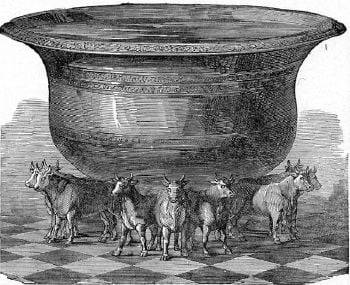
- Surrounding the building were the court of the priests (2 Chron. 4:9), called the "inner court" (1 Kings 6:36) and the great court, which surrounded the whole Temple (2 Chron. 4:9). Here the common people assembled to worship God.
The court of the priests was the sacrificial center of the Temple complex. It contained the main altar for burnt offerings (2 Chron. 15:8), the brazen sea (4:2-5, 10), and ten ornate lavers (1 Kings 7:38, 39). From 2 Kings 16:14 the altar is described as being made of bronze, standing before the Temple; 2 Chron. 4:1 gives its dimensions as 20 cubits square and 10 cubits high. The lavers, each of which held "forty baths" (1 Kings 7:38), rested on portable holders made of bronze, provided with wheels, and ornamented with figures of lions, cherubim, and palm-trees.
The Religion of the Temple
Intellectual and cultural significance
The Temple was an important symbol of national unity. Its size, architectural glory, rich treasures, and the power of its God represented the Israelite and Jewish nation to the world. It was also a key center of literacy and learning.
Here, priests not only copied holy scriptures, but wrote psalms, histories, and wisdom literature. The Temple was the locus of important political movements and spawned at least one coup against rulers who did not pay heed to priestly and prophetic advice (2 Kings 11). In its courts, prophets such as Jeremiah denounced religious complacency, warning that social justice is even more important to God than sacrifices (Jeremiah 7). In its chambers royal infants were sheltered from palace intrigues which targeted them for murder (2 Kings 11:3), and sacred scrolls were uncovered that launched dramatic religious reforms (2 Kings 22-23).
Scholars debate how much all of this affected the masses of people. Jerusalem was only one of several important cities during the First Temple period, and the majority of people lived in the countryside in any case. Even in those times when Yahwistic kings ruled and attempted to unify the religious tradition, there are indications (both Biblical and archaeological) that for most people, religion was not exclusively Yahwistic. In the Second Temple period, however, the monotheistic tradition prevailed not only in Jerusalem, but among the Jews throughout the land of Judea and the Diaspora.
Devoted to The Lord
The Jerusalem Temple is portrayed in the biblical account as belonging exclusively to the Israelite God Yahweh ("The Lord"). Other altars, even if devoted to Israelite deity, were specifically prohibited:
- …To the place the Lord your God will choose as a dwelling for his Name—there you are to bring everything I command you: your burnt offerings and sacrifices, your tithes and special gifts, and all the choice possessions you have vowed to the Lord…. Be careful not to sacrifice your burnt offerings anywhere you please. Offer them only at the place the Lord will choose in one of your tribes, and there observe everything I command you. (Deut. 12:11-14)
According to Biblical tradition, when the people of Judah and Israel united centering on the Temple and resisted the temptation of worshiping Canaanite deities, God blessed them; however, when they sacrificed elsewhere or followed after foreign gods, they were punished. From the biblical viewpoint, the reason for the demise of both Israel and Judah was their lack of faith God, centered in Jerusalem and its holy Temple, which was said to be God's only authorized sanctuary.
Modern scholars, however, tend to believe that this Jerusalem-centered "Yahweh-only" principle did not come to the fore until the seventh century B.C.E., contemporary with the writing of Deuteronomy. Early Israelite religion may have affirmed Yahweh (also call "El" in the Bible) as the chief deity, while also recognizing the existence of lesser deities such as Asherah (El's consort) and even Baal. Parts of the Bible clearly acknowledge the real existence of the non-Israelite deities, forbidding their worship to Israelites but not to gentiles. Accordingly, only gradually did the idea of "one God alone" emerge and prevail.
The biblical history indicates that Solomon himself honored the gods of his foreign wives as well as the Israelite God, but he did not worship these gods in the Temple itself. The Bible reports that temples to other deities existed in Jerusalem at various period. Some kings allowed Solomon's Temple to fall into disrepair and introduced the worship of other deities in its confines. From 700-600 B.C.E., for example:
- King Ahaz, as well as earlier rulers, removed gold, silver, and bronze sacred treasures and furnishings from the Temple to pay tribute demanded by Syrian and Assyrian kings. The Temple also suffered from lack of use and poor maintenance. "They… shut the doors of the portico and put out the lamps. They did not burn incense or present any burnt offerings at the sanctuary to the God of Israel." (2 Chron. 29:7)
- King Hezekiah, the son of Ahaz, also removed sacred treasures to pay tribute to Assyria. Later, under the influence of the prophet Isaiah, he effected repairs and re-consecrated the Temple. He also carried out an aggressive campaign against non-Yahwistic religious practices, even destroying the bronze serpent created by Moses during the exodus, originally an authorized object of faith, but now seen as idolatrous. (2 Kings 18)
- King Manasseh (Hezekiah's son) erected an "Ashera pole" and several altars in the Temple devoted to non-Israelite deities. During his 55-year reign, as well as the 22-year reign of his son Amon, the Yahweh-only principle of Hezekiah's day was abandoned, and the Temple became a cosmopolitan religious center honoring the various deities of Judah's population.
- By the time of King Josiah (late seventh century B.C.E.) the Bible reports that in addition to the above-mentioned pagan shrines, the Temple housed sacred male prostitutes, women who wove clothing for the goddess Asherah, and "articles made for Baal and Asherah and all the starry hosts." (2 Kings 23)
Josiah instituted a radical campaign to rid the Temple of Canaanite religious practices, unify the priesthood in Jerusalem, and repress unauthorized religion throughout his kingdom. This campaign went beyond previous attempts at reform in both scope and zeal, aiming at Yahwist "high places" outside of Jerusalem as well as shrines devoted to Baal and Ashera worship. It extended even to the former territory of the Northern Kingdom of Israel, where Josiah supervised the destruction of the Israelite shrine at Bethel, whose original altar had reportedly been established by Abraham himself (2 Kings 22-23).
The Centrality of Jerusalem
The Bible stipulates that before Solomon's time, Israelite worship and sacrifice took place at various "high places," supervised by both priests and prophets. After the Temple's establishment, however, it became the national shrine. A movement aimed at centralization centering on Jerusalem ebbed and waned over the next four centuries.
After Israel split from Judah during the reign of Solomon's son Rehoboam, the Northern king Jeroboam built two rival national shines: one at the ancient high place of Bethel a few miles north of Jerusalem, the other near the border of today's Lebanon in the territory of Dan. The Biblical authors, who emphasized the centrality of Jerusalem and also criticized the erection of golden bull-calf statues at these sanctuaries, denounced these shrines. (Critics point out that in so doing they turned a blind eye to the large statues of bronze bulls and golden cherubim in the Jerusalem Temple.)
Occasionally, local high places operated during this period without disapproval from the Biblical writers. Prophetic bands attended various high places: Bethel, Jericho, Gibeah etc. The prophet Elijah offered sacrifice to God at the high place on Mount Carmel. Of particular interest historically is the high place at Gerizim (above the town of Shechem), a Yahwistic shrine seen by the Samaritan-Israelites as the one true authorized place of sacrifice, as opposed to Jerusalem. This shrine receives little attention in the Hebrew Bible, but is mentioned in the New Testament as the holy place of the Samaritans (John 4:20), and remains the center of the modern Samaritan sect today.
As part of Hezekiah's and Josiah's centralization campaigns, only Levite priests were considered legitimate, and any such priests operating at the high places were required to report to the Jerusalem Temple. Archaeologists have confirmed that some local shrines indeed ceased operation during these periods. After the Jews returned from exile and rebuilt the Temple in Jerusalem, it became the unrivaled Temple of the Jews.
Ceremony and sacrifice
Sacrifices of various types were central to the Temple's function. Priests offered animal, vegetable, and wine sacrifices on behalf of both king and people. Specifications are given in the books of Exodus, Leviticus, Numbers, and Deuteronomy. However, it should be noted that the mature tradition of sacrifice probably emerged rather late in the period of Kings and did not reach its final form until after the return from exile in Babylon.
From the Psalms and other liturgical works can be derived a rich tradition of procession, song, dance, religious festival, priestly devotions, and royal enthronement rituals centering on the Temple. The following examples of psalmistry take on added meaning when considered in light of their original Temple-based context.
- One thing I ask of the Lord, this is what I seek: That I may dwell in the house of the Lord all the days of my life. To gaze upon the beauty of the Lord and to seek him in his Temple… (Psalm 27:4)
- Shout for joy to the Lord, all the earth. Worship the Lord with gladness. Come before him with joyful songs. Know that the Lord is God…. Enter his gates with thanksgiving and his courts with praise. (Psalm 100)
Comparison with other temples
The Temple has recognizable similarities to other temples of its time and region. The Biblical text makes it clear that Solomon received aid from Hiram of Tyre in the construction of his buildings. This aid involved not only material (cedar-wood, etc.), but also architectural direction and skilled craftsmen. Amongst them was a master coppersmith, also called Hiram. The Temple's tripartite division is similar to that found in thirteenth century B.C.E. temples at Alalakh in Syria and Hazor in the upper Galilee; a ninth century B.C.E. temple at Tell Tayinat also follows this plan. Phoenician temples varied somewhat in form, but were similarly surrounded by courts.
Among the details that were probably copied from Tyre were the two large bronze pillars Jachin and Boaz. Herodotus (ii. 44) says that the temple at Tyre contained two such, one of emerald and the other of fine gold. The bronze altar, too, may have been a Phoenician innovation. The Orthodox Israelite altar was of earth or unhewn stone. In the same way the ubiquitous ornamentation of palm trees and cherubim were probably derived from Tyre, as may have been the cast and carved images of bulls, pomegranates, flowers, etc. These details pose a paradox, for the Ten Commandments of Ex. 20 prohibited the making of graven images, while that of Ex. 34 prohibited the making of molten gods; and the Deuteronomic version prohibited the making of an image of "anything in heaven above or on the earth beneath or in the waters below." All these writings, according the Bible critics, are later than Solomon's time; but there is no reason to believe that prior to the Temple's construction the Hebrews had either the skill or the wealth necessary to produce ornamentation of this kind.
Solomon's Temple embodied features derived from many surrounding cultures. It was on the summit of a hill, like the altar of Ba'al on Mount Carmel, the sanctuaries of Mount Hermon, and the Babylonian idea of the divine abode on high. It was surrounded by courts, like the Phoenician temples and the splendid temple of Der al-Bakri at Thebes. Its general form also reminds students of ancient architecture of several Egyptian sanctuaries.
The chambers which surrounded the Holy Place in Solomon's Temple are said in 1 Chron. 28:12 to have been storehouses for the sacred treasure. These are paralleled in Babylonian and Egyptian temples by similar chambers. The "molten sea" finds its parallel in Babylonian temples in a great basin called the apsu (“deep”). As the ziggurat typified a mountain, so the apsu typified the sea. The Temple, with the "sea" standing before it, thus became a miniature world.
The Temple and Christianity
The dominant view within Protestant Christianity is that animal sacrifices within the Temple were a foreshadowing of the sacrifice Jesus made for the sins of the world, through his death (see especially the New Testament letter to the Hebrews). As such, they believe there is no longer a need for the physical Temple and its rituals.
However, in recent years there has been a tendency in some Christian circles to acknowledge the fact that for years after Jesus' death, his closest disciples—including even Saint Paul in Acts 22—participated in Temple rituals and continued to live as practicing Jews. Some Protestants do believe in the importance of a future rebuilt Temple (i.e. some dispensationalists and “Messianic Jews”). Some believe that there will be a full restoration of the sacrificial system as described in Ezekiel's vision of the Temple (Ezek. 43-44).
The Catholic and Orthodox churches believe that the Eucharist is a far superior offering when compared with the merely preparatory Temple sacrifices, as explained in the Epistle to the Hebrews. They also believe that the Christian church buildings where the Eucharist is celebrated are the legitimate successors of the Temple. Therefore they do not generally attach any significance to a possible future rebuilding of the Jerusalem Temple.
The Temple has particular significance in the tradition of the Latter Day Saints. Joseph Smith taught that not only would the Temple in Jerusalem be rebuilt, but that its counterpart would be built in the United States. The land where this temple was prophesied to be built is in Independence, Missouri.
In addition, Freemasonry's origin stories harken back to secret knowledge reportedly passed down through the ages by an ancient the fraternity of the builders Solomon’s Temple.
Rebuilding the Temple?
Ever since its destruction in 70 C.E., Jews have prayed that God will allow for the rebuilding of the Temple. This prayer is a formal part of the thrice-daily orthodox Jewish prayer services. Not all rabbis agree, however, on what would happen in a rebuilt Temple, or even if a Temple should be rebuilt at all. It has traditionally been assumed that some sort of animal sacrifices would be re-instituted, in accord with the rules in Leviticus and the Talmud. However there is another opinion, beginning with Maimonides, that God deliberately has moved Jews away from sacrifices and toward prayer, as prayer is a higher form of worship. Today the main branches of Judaism line up on the question as follows:
- Orthodox Judaism believes and prays that the Temple will be rebuilt and that the sacrificial services, known as the korbanot will once again be practiced with the rebuilding of a Third Temple. Most religious Jews feel that the Temple should only be rebuilt in the messianic era, and that it would be presumptuous of people to force God's hand by rebuilding it themselves.
- Conservative Judaism has modified these prayers; its prayer books call for the restoration of Temple, but do not ask for resumption of animal sacrifices. Most of the passages relating to sacrifices are replaced with the Talmudic teaching that deeds of loving-kindness now atone for sin.
- Reform Judaism calls neither for the resumption of sacrifices nor the rebuilding of the Temple, although some new Reform prayer books are moving towards calling for the latter as an option.
A few Christian fringe groups advocate constructing a Third Temple today, believing it to be a necessary precursor to the Second Coming of Christ. Almost all Jews—including the majority of the Orthodox—oppose this. Additionally, of course, the Israeli government is dead set against rebuilding the Temple due to the enormously hostile reaction from Muslims that would likely result. The Dome of the Rock and Al-Aqsa Mosque were built on the site of the destroyed Jewish Temples several centuries after the destruction of the Jewish Temple. The Temple Mount is believed by Muslims to be the place where the prophet Muhammad ascended to heaven. Israel has pledged to honor the integrity of the Mosque and the rights of Muslims to worship there.
Notes
- ↑ 1 Chronicles 12:14 Skeptics Annotated Bible. Retrieved January 16, 2020.
- ↑ Temple, Solomon’s Easton's Bible Dictionary. Retrieved January 16, 2020.
- ↑ Temple of Solomon Jewish Encyclopedia. Retrieved January 16, 2020.
ReferencesISBN links support NWE through referral fees
- Conner, Kevin J. The Temple of Solomon. City Christian Publishing, 1995. ISBN 978-0914936961
- De Vaux, Roland. Ancient Israel: Its Life and Institutions, tr. John McHugh). Wm. B. Eerdmans Publishing Co., 1997. ISBN 978-0802842787
- Finkelstein, Israel, and David Silberman. David and Solomon: In Search of the Bible's Sacred Kings and the Roots of the Western Tradition. New York: Free Press/ Simon and Schuster, 2006. ISBN 0743243625
External links
All links retrieved February 26, 2023.
- Solomon's Temple Phoenicia.org.
- The Jewish Temples Jewish Virtual Library.
- Temple of Solomon Jewish Encyclopedia.
- Solomon’s Words For The Wise Faith Giant.
Credits
New World Encyclopedia writers and editors rewrote and completed the Wikipedia article in accordance with New World Encyclopedia standards. This article abides by terms of the Creative Commons CC-by-sa 3.0 License (CC-by-sa), which may be used and disseminated with proper attribution. Credit is due under the terms of this license that can reference both the New World Encyclopedia contributors and the selfless volunteer contributors of the Wikimedia Foundation. To cite this article click here for a list of acceptable citing formats.The history of earlier contributions by wikipedians is accessible to researchers here:
The history of this article since it was imported to New World Encyclopedia:
Note: Some restrictions may apply to use of individual images which are separately licensed.
